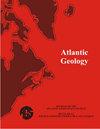Provenance and paleogeography of post-Middle Ordovician, pre-Devonian sedimentary basins on the Gander composite terrane, eastern and east-central Maine: implications for Silurian tectonics in the northern Appalachians
IF 0.9
4区 地球科学
Q2 GEOLOGY
引用次数: 8
Abstract
Recent mapping in eastern and east-central Maine addresses long-standing regional correlation issues and permits reconstruction of post-Middle Ordovician, pre-Devonian paleogeography of sedimentary basins on the Ganderian composite terrane. Two major Late Ordovician-Silurian depocenters are recognized in eastern Maine and western New Brunswick separated by an emergent Miramichi terrane: the Fredericton trough to the southeast and a single basin comprising the Central Maine and Aroostook-Matapedia sequences to the northwest. This Central Maine/Aroostook-Matapedia (CMAM) basin received sediment from both the Miramichi highland to the east and highlands and islands to the west, including the pre-Late Ordovician Boundary Mountains, Munsungun-Pennington, and Weeksboro-Lunksoos terranes. Lithofacies in the Fredericton trough are truncated and telescoped by faulting along its flanks but suggest a similar basin that received sediment from highlands to the west (Miramichi) and east (St. Croix). Deposition ended in the Fredericton trough following burial and deformation in the Late Silurian, but continued in the CMAM basin until Early Devonian Acadian folding. A westward-migrating Acadian orogenic wedge provided a single eastern source of sediment for the composite CMAM basin after the Salinic/Early Acadian event, replacing the earlier, more local sources. The CMAM, Fredericton, and Connecticut Valley-Gaspe depocenters were active immediately following the Taconian orogeny and probably formed during extension related to post-Taconian plate adjustments. These basins thus predate Acadian foreland sedimentation. Structural analysis and seismic reflection profiles indicate a greater degree of post-depositional crustal shortening than previously interpreted. Late Acadian and post-Acadian strike-slip faulting on the Norumbega and Central Maine Boundary fault systems distorted basin geometries but did not disturb paleogeographic components drastically.缅因州东部和中东部甘德复合地体上后中奥陶世、前泥盆纪沉积盆地的物源和古地理:对阿巴拉契亚山脉北部志留系构造的启示
最近在缅因州东部和中东部的测绘解决了长期存在的区域对比问题,并允许重建中奥陶世后、前泥盆世沉积盆地在Ganderian复合地体上的古地理。在缅因州东部和新不伦瑞克省西部发现了两个主要的晚奥陶世-志留纪沉积中心,它们被一个新兴的米拉米奇地体分隔开来:东南部的弗雷德里克顿海槽和西北部的一个由缅因州中部和aroostok - matapedia序列组成的单一盆地。这个中缅因/阿鲁斯托克-马塔佩迪亚(cam)盆地吸收了东部的米拉米奇高地和西部的高地和岛屿的沉积物,包括晚奥陶世前的边界山脉、Munsungun-Pennington和Weeksboro-Lunksoos地体。弗雷德里克顿海槽的岩相因其两侧的断裂而被截断和收缩,但表明一个类似的盆地,从西部(米拉米奇)和东部(圣克罗伊)的高地吸收了沉积物。晚志留世埋藏变形后沉积结束于Fredericton海槽,但在cmm盆地继续沉积至早泥盆世阿卡叠世。在盐期/早阿卡迪亚事件后,向西迁移的阿卡迪亚造山楔为复合盆地提供了单一的东部沉积源,取代了早期的局部沉积源。cmm、Fredericton和Connecticut Valley-Gaspe沉积中心在Taconian造山运动之后立即活跃,可能形成于与后Taconian板块调整有关的伸展过程中。因此,这些盆地早于阿卡迪亚前陆沉积。构造分析和地震反射剖面表明,沉积后地壳缩短的程度比以前解释的要大。诺伦贝加和中缅因边界断裂系统上的晚阿卡迪亚和后阿卡迪亚走滑断裂扭曲了盆地的几何形状,但对古地理成分没有明显的干扰。
本文章由计算机程序翻译,如有差异,请以英文原文为准。
求助全文
约1分钟内获得全文
求助全文
来源期刊

Atlantic Geology
GEOLOGY-
CiteScore
2.10
自引率
18.80%
发文量
0
审稿时长
>12 weeks
期刊介绍:
Atlantic Geology (originally Maritime Sediments, subsequently Maritime Sediments and Atlantic Geology) covers all aspects of the geology of the North Atlantic region. It publishes papers, notes, and discussions on original research and review papers, where appropriate to the regional geology.
 求助内容:
求助内容: 应助结果提醒方式:
应助结果提醒方式:


